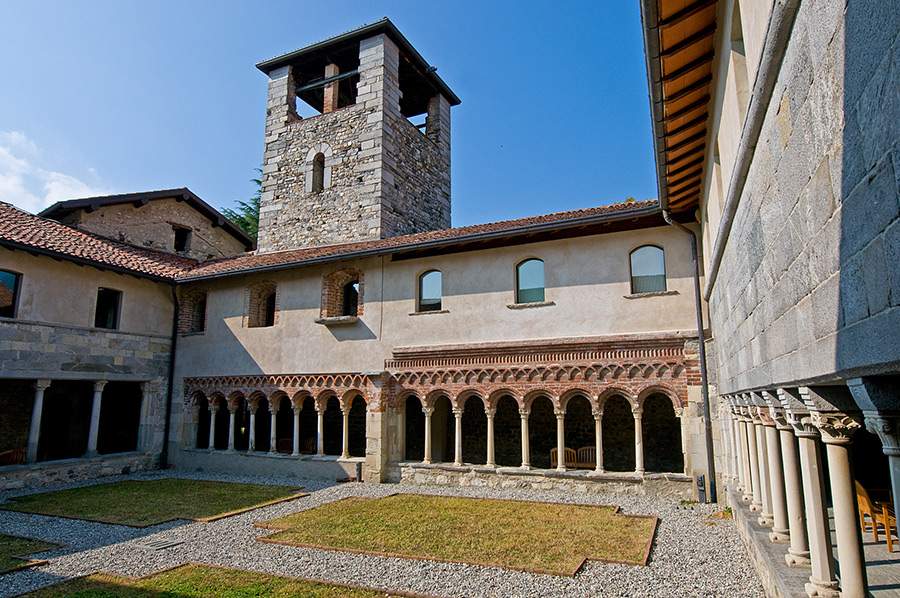Varese, at the monastery of Cairate an exhibition on the daily life of the Lombards
From September 24 to October 16, 2022, the monastery of Cairate, in the province of Varese, will host, after the Castelseprio-Torba stop, the traveling exhibition Trame longobarde. Between Architecture and Textiles, a cultural initiative promoted by the Associazione Italia Langobardorum, management structure of the UNESCO site “The Lombards in Italy. Places of Power (568-774 A.D.),” to enhance and spread knowledge of the Lombard civilization on Italian territory.
The exhibition, set up in the rooms of the former Benedictine women’s monastery of Santa Maria Assunta in Cairate, founded in the Lombard era, is presented to the public as an important work of reconstruction, based on archaeological data, of the daily life of the Lombards. It is a journey through textiles, clothing and jewelry produced by this extraordinary civilization that generated a successful synthesis of Roman-Classic heritage and Germanic cultural input in the transitional period between the Late Antique Age and the Early Middle Ages. All the dresses on display were half made from fabrics made strictly by hand on horizontal heald looms reproducing exactly the number of warp and weft threads present at the cm, as well as the thickness of the threads themselves and the twists. The other half of the dresses were made by employing an industrial cotton cloth precisely to emphasize that the pattern of the repurposed dress is the result of scientific contamination and elaboration by the curators.
Thefabrics and borders were made in the Spoleto (Perugia) House of Reclusion, by inmates of the weaving course, with the looms of IIS Sansi Leonardi Volta, after a meticulous work of study and reconstruction of wefts and warps inferred from archaeological discoveries. The composition of men’s and women’s dress was made with careful iconographic comparisons combined with the few literary sources(Historia Langobardorum by Paolo Diacono). The result is an accurate proposal of the ancient weaving and cutting and sewing techniques of early medieval dress. The different social classes are represented complemented by accessories made by inmates of the Restricted High School of Art. The visitor, led by equine icons and spears among artifacts from the 4th to 8th centuries, meets the protagonists of Lombard plots in front of large photographic backdrops of the seven architectural monuments that make up the serial site “The Lombards in Italy. Places of Power (568-774 AD).”
The exhibition, curated by Glenda Giampaoli and Giorgio Flamini, with the scientific comparison of Donatella Scortecci, and realized thanks to the resources of the Region of Umbria, the Ministry of Culture and the Associazione Italia Langobardorum, is part of the initiatives promoted for the celebration of the 10th anniversary of the UNESCO recognition of the serial site "The Lombards in Italy. Places of Power (568-774 A.D.), " including the seven localities distributed in five Italian regions that preserve the most significant architectural signs of the degree of civilization achieved by this people who arrived in Italy in the second half of the sixth century.
A polyethnic grouping coming from the plains of Pannonia, but with origins connected to Scandinavia, the Lombards, led by King Alboin, settled, after penetrating Friuli in 568 A.D., in various territories of the Italian peninsula, showing themselves capable, in the following decades, of combining their Germanic substratum with the classical and Roman-Christian tradition, accrediting themselves, perhaps even more than the Byzantines, as the continuers of Roman civilization.
The Associazione Italia Langobardorum - formally established in 2009 by the municipalities of Benevento, Brescia, Campello sul Clitunno (PG), Castelseprio (VA), Gornate Olona (VA), Cividale del Friuli (UD), Monte Sant’Angelo (FG), Spoleto (PG) and the Ministry of Heritage and Cultural - is the management structure of the Serial Site, which is responsible for initiating, coordinating and monitoring network actions related to the enhancement and promotion of the UNESCO site of the Lombard civilization, of which they include: the Gastaldaga area and episcopal complex in Cividale del Friuli (UD), the Sanctuary of San Michele in Monte Sant’Angelo (FG), themonumental area with the Monastery of San Salvatore-Santa Giulia in Brescia, the castrum with the Tower of Torba and the Church of Santa Maria Foris Portas in Castelseprio and Torba (VA), the Basilica of San Salvatore in Spoleto (PG), the Tempietto del Clitunno in Campello sul Clitunno (PG) and the Complex of Santa Sofia in Benevento.
For visits to the exhibition at Cairate Monastery until Sept. 30 Saturday 2:30-6:30 p.m., Sunday 10 a.m.-12 p.m. / 2:30-6:30 p.m. October 1 to 16 Saturdays and Sundays 2 to 5 p.m. For information and reservations: prolococairate@gmail.com - tel. 3451018929.
Pictured: the cloister of the Cairate monastery.
 |
| Varese, at the monastery of Cairate an exhibition on the daily life of the Lombards |
Warning: the translation into English of the original Italian article was created using automatic tools. We undertake to review all articles, but we do not guarantee the total absence of inaccuracies in the translation due to the program. You can find the original by clicking on the ITA button. If you find any mistake,please contact us.




























